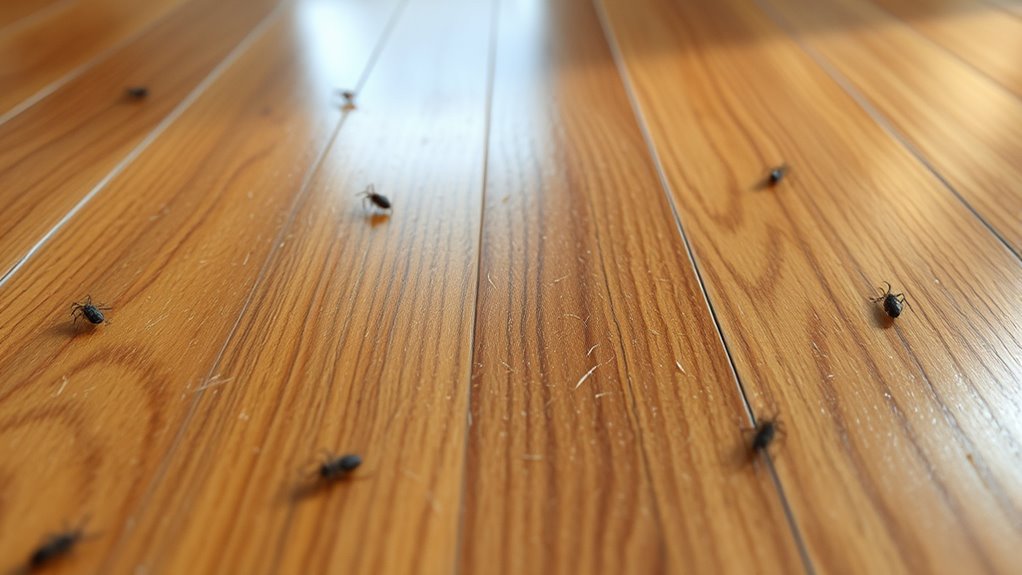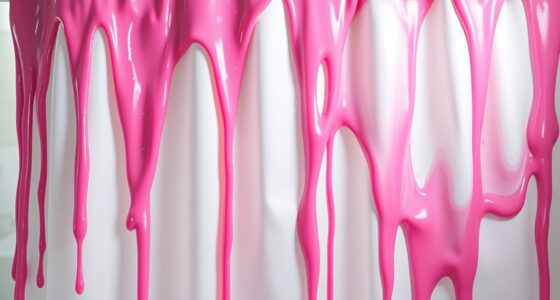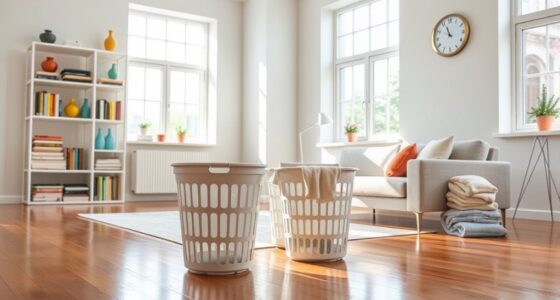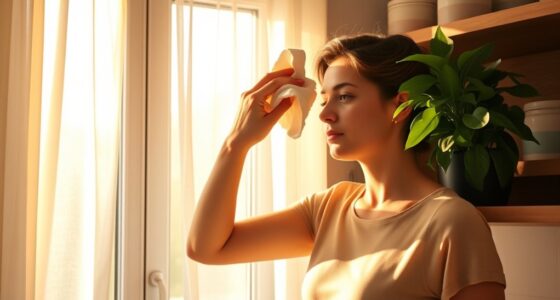Many floors can hide bacteria that pose health risks, especially if not cleaned properly. Studies show proper mopping, changing water frequently, and using the right products considerably reduce germs. Porous surfaces like hardwood need gentler care, while non-porous floors are easier to disinfect. Regular cleaning in high-traffic areas is key to prevent cross-contamination. If you want to guarantee your floors are truly hygienic, there are important details about effective cleaning techniques you should know.
Key Takeaways
- Proper mopping techniques and frequent water changes significantly reduce bacteria levels on floors.
- Non-porous surfaces like tiles are easier to disinfect thoroughly compared to porous materials.
- Regular cleaning and appropriate products lower the risk of cross-contamination and illness.
- Poor hygiene practices can lead to higher bacterial presence, increasing health risks in households.
- Using suitable cleaning methods and materials ensures floors are genuinely sanitized and safe.

Have you ever wondered how much dirt and bacteria can accumulate on your floors? It’s surprising just how quickly germs and grime can build up, especially if you don’t pay close attention to cleaning methods. The way you mop makes a big difference. Using the right mopping techniques ensures you remove more dirt and prevent the spread of bacteria. For example, starting with a clean mop and changing the water frequently helps lift dirt rather than just spreading it around. Wringing out the mop properly and using a two-bucket system—one for clean water and one for rinsing—can also improve your results. It might seem simple, but these small adjustments can considerably reduce bacteria levels. Additionally, the type of floor material you have influences how you should approach cleaning. For instance, smooth, non-porous surfaces like ceramic tiles or vinyl are easier to clean thoroughly because they don’t trap dirt as much. You can use a damp mop with a disinfectant solution, and it’ll effectively pick up bacteria. On the other hand, porous materials like hardwood or laminate require gentler cleaning techniques and specialized cleaning products to avoid damage while maintaining hygiene. For hardwood floors, using a lightly damp cloth or mop and avoiding excess moisture prevents warping or staining. In contrast, more absorbent surfaces can harbor bacteria within their pores, making it essential to choose cleaning agents formulated for those materials. It’s also wise to take into account the cleaning frequency—more often than you think—especially in high-traffic areas. Regular sweeping or vacuuming removes loose dirt, while mopping with effective techniques ensures deeper sanitation. Certain studies reveal that neglecting proper cleaning can lead to higher levels of bacteria on floors, which can then transfer onto your shoes, clothing, and even your hands. This cross-contamination increases the risk of illnesses, particularly in households with children or elderly family members. So, it’s not just about appearance; it’s about health. Knowing which cleaning products suit your floor type and mastering proper mopping techniques helps you maintain a safer, healthier environment. Remember, clean floors aren’t just for looks—they’re a vital part of hygiene that often gets overlooked. Paying attention to these details makes a real difference in reducing germs and maintaining a healthier home. By adopting the right mopping practices and understanding your floor material, you’ll be better equipped to keep your floors genuinely clean and safe for everyone in your household.
Frequently Asked Questions
How Often Should I Professionally Deep Clean My Floors?
You should schedule a professional deep clean for your floors every 6 to 12 months. During this time, professionals can perform floor waxing on wooden surfaces and carpet steaming to eliminate hidden dirt and bacteria. Regular deep cleaning maintains your floors’ appearance and hygiene, preventing wear and tear. If you have high-traffic areas or pets, consider more frequent sessions to keep your floors spotless and healthy.
Do Different Flooring Materials Harbor More Germs?
You might think some flooring materials harbor more germs, but studies show bacterial accumulation varies by surface type. Hard surfaces like tile and laminate tend to retain fewer germs because they’re easier to clean thoroughly. Conversely, carpets and porous flooring can trap dirt and bacteria, increasing germ retention over time. So, choosing the right flooring and maintaining regular cleaning can substantially reduce bacterial buildup and keep your home healthier.
Can Cleaning Products Harm Certain Types of Floors?
Cleaning products can harm certain floors by causing surface damage or leaving chemical residues. If you use harsh chemicals on wood or laminate floors, you might strip away finishes or dull their appearance. Always check manufacturer recommendations before cleaning, and opt for gentle, appropriate products. This helps protect your floors from damage and keeps them looking their best without risking surface deterioration or lingering chemical residues.
Are Robotic Floor Cleaners as Effective as Manual Cleaning?
Robotic floor cleaners can be just as effective as manual cleaning, thanks to their robotic efficiency. They consistently cover surfaces and pick up dirt, dust, and hair, making them a strong choice for routine maintenance. While manual cleaning allows for detailed spot cleaning, automated devices excel in quick, regular upkeep. The key is to choose a model that fits your floor type and cleaning needs, ensuring thorough, hassle-free results.
What Are the Best Methods to Disinfect Floors Safely?
Sure, disinfecting floors is just a splash of bleach away, but don’t forget the irony—your efforts might combat mold prevention and dust accumulation, yet neglecting proper safety measures can backfire. To do it safely, use EPA-approved disinfectants, follow manufacturer instructions, and wear gloves and masks. Regular sweeping, mopping with microfiber cloths, and proper ventilation make the process effective without risking your health or the cleanliness of your floors.
Conclusion
So, next time you walk across your floors, remember—they might hide more than just dust. While your floors often seem spotless, tiny unseen visitors could be lurking below the surface. A quick clean might not be enough to keep everything at bay. Giving your floors a little extra attention can make a big difference in keeping your home truly healthy. After all, a little extra care now can prevent bigger surprises later.









